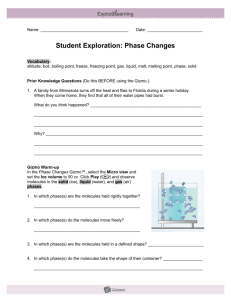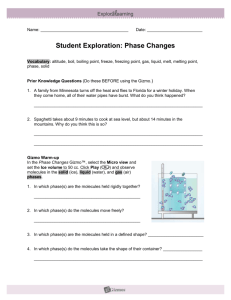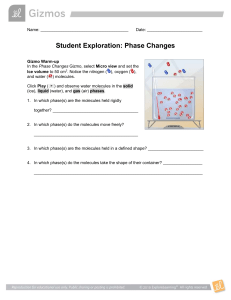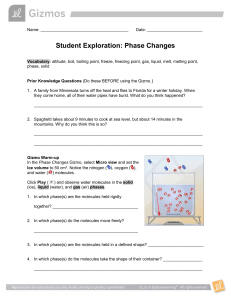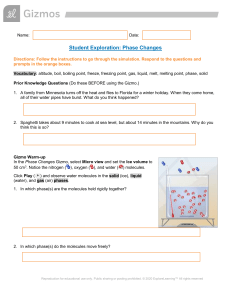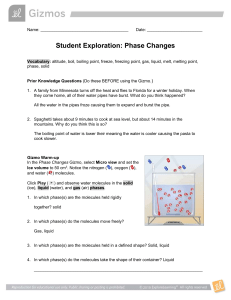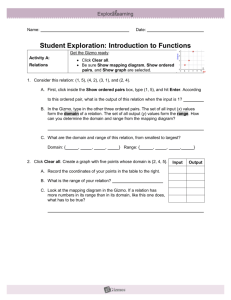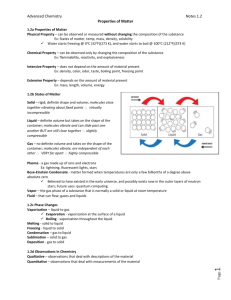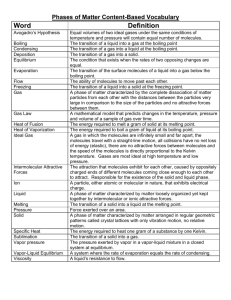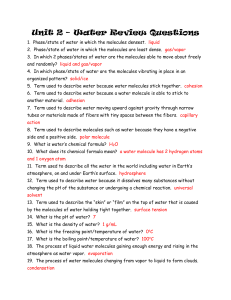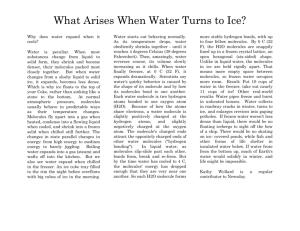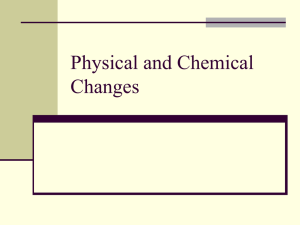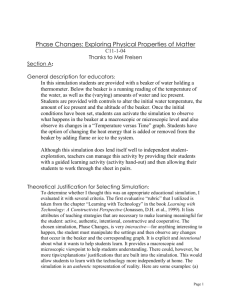Phase Changes
advertisement
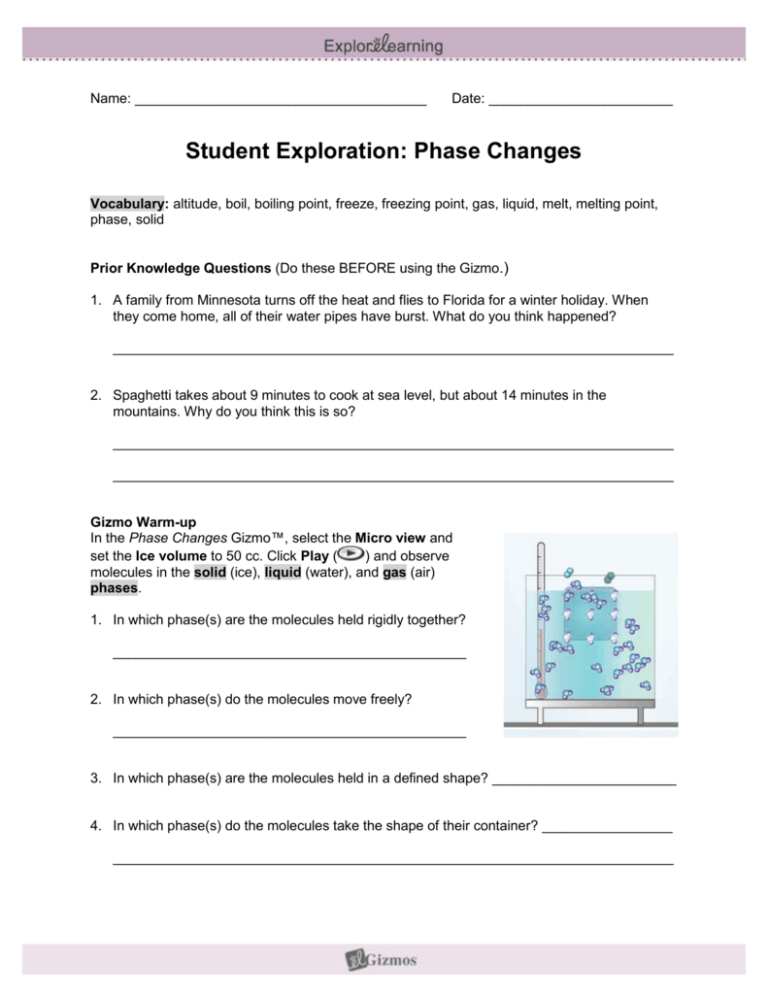
Name: ______________________________________ Date: ________________________ Student Exploration: Phase Changes Vocabulary: altitude, boil, boiling point, freeze, freezing point, gas, liquid, melt, melting point, phase, solid Prior Knowledge Questions (Do these BEFORE using the Gizmo.) 1. A family from Minnesota turns off the heat and flies to Florida for a winter holiday. When they come home, all of their water pipes have burst. What do you think happened? _________________________________________________________________________ 2. Spaghetti takes about 9 minutes to cook at sea level, but about 14 minutes in the mountains. Why do you think this is so? _________________________________________________________________________ _________________________________________________________________________ Gizmo Warm-up In the Phase Changes Gizmo™, select the Micro view and set the Ice volume to 50 cc. Click Play ( ) and observe molecules in the solid (ice), liquid (water), and gas (air) phases. 1. In which phase(s) are the molecules held rigidly together? ______________________________________________ 2. In which phase(s) do the molecules move freely? ______________________________________________ 3. In which phase(s) are the molecules held in a defined shape? ________________________ 4. In which phase(s) do the molecules take the shape of their container? _________________ _________________________________________________________________________ Get the Gizmo ready: Activity A: Phase changes Click Reset ( ) and select Macro view. Set the Water temperature to 10 °C. Set the Ice volume to 0 cc. Question: How is temperature related to phase changes? 1. Predict: Based on your prior knowledge, predict the following: A. At what temperature will water change from a liquid to a solid (freeze)? _______ B. At what temperature will water change from a solid to a liquid (melt)? _______ C. At what temperature will water change from a liquid to a gas (boil)? _______ 2. Investigate: Use the Gizmo to explore phase changes. Use the Add/remove heat energy slider to control the water temperature. Record your observations in your notes, then answer the questions below: A. At what temperature does water freeze? _______ This is the freezing point. B. At what temperature does ice melt? _______ This is the melting point. C. At what temperature does water boil? _______ This is the boiling point. 3. Observe: Set up the Gizmo to observe freezing. What do you notice about the temperature while the water is in the process of freezing? _____________________________________ 4. Explore: Use the Gizmo to investigate melting and boiling. Does the temperature change while either of these phase changes is occurring? _________________________________ 5. Interpret: Select the GRAPH tab to see a graph of temperature vs. time. Click the “–” button until the whole graph is visible. What does the graph look like during a phase change? _________________________________________________________________________ 6. Extend your thinking: Why do you think the temperature does not change much during a phase change? If possible, discuss your answer with your classmates and teacher. _________________________________________________________________________ _________________________________________________________________________ Get the Gizmo ready: Activity B: Temperature and molecular motion Click Reset, and select the Micro view. Set Ice volume to 0 cc. Set Add/remove heat energy to 0 J/s. Question: Why do phase changes occur? 1. Compare: Set the Water temperature to 0 °C and click Play. Observe the water molecules. Click Reset, set the Water temperature to 100 °C, and click Play again. What do you notice? ________________________________________________________ _________________________________________________________________________ 2. Observe: Click Reset. The mean molecular speed of the water molecules is displayed below the container. Set the Water temperature to 0 °C and Add/remove heat energy to 400 J/s. Click Play. A. How does the mean speed of the water molecules change as they are heated? ________________________________________________________________ B. Does the mean molecular speed change as much as the temperature as the water heats up? Explain. ________________________________________________________________ ________________________________________________________________ ________________________________________________________________ 3. Explain: How is temperature related to the motions of molecules? _____________________ _________________________________________________________________________ _________________________________________________________________________ 4. Observe: Click Reset. Set the Water temperature to 20 °C and the Ice volume to 50 cc. Set Add/remove heat energy to 0 J/s. Click Play. How do the molecules in the liquid interact with the molecules in the solid? _________________________________________________________________________ _________________________________________________________________________ (Activity B continued on next page) Activity B (continued from previous page) 5. Observe: Click Reset. Set the Water temperature to 100 °C and the Ice volume to 50 cc. Click Play. How does this situation compare to the previous one? _________________________________________________________________________ _________________________________________________________________________ 6. Propose a theory: Based on what you have observed, explain why you think phase changes occur. If possible, discuss your theory with your classmates and teacher. _________________________________________________________________________ _________________________________________________________________________ _________________________________________________________________________ _________________________________________________________________________ 7. Apply: Use your theory to explain what happens at the molecular level in each of the following situations. Also, list the temperature at which each transition occurs. A. Ice is warmed to the melting point. _______________________________________ __________________________________________________ Temperature: _____ B. Water is warmed to the boiling point. ______________________________________ __________________________________________________ Temperature: _____ C. Water is cooled to the freezing point. _____________________________________ __________________________________________________ Temperature: _____ 8. Extend your thinking: Click Reset. Set the Water temperature to 0 °C, the Ice volume to 0 cc, and Add/remove heat energy to -400 J/s. Click Play and wait until all the water freezes. A. What volume of ice is created from 200 cc of water? _________________________ B. Why do water pipes sometimes burst in the winter? __________________________ ___________________________________________________________________
